Henry II of France
Henry II (French: Henri II; 31 March 1519 – 10 July 1559) was King of France from 31 March 1547 until his death in 1559. The second son of Francis I, he became Dauphin of France upon the death of his elder brother Francis III, Duke of Brittany, in 1536.
| Henry II | |
|---|---|
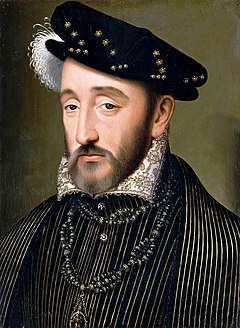 Portrait by François Clouet | |
| King of France | |
| Reign | 31 March 1547 – 10 July 1559 |
| Coronation | 25 July 1547 |
| Predecessor | Francis I |
| Successor | Francis II |
| Born | 31 March 1519 Château de Saint-Germain-en-Laye |
| Died | 10 July 1559 (aged 40) Hôtel des Tournelles |
| Burial | 13 August 1559 Saint Denis Basilica |
| Spouse | |
| Issue among others... |
|
| House | Valois-Angoulême |
| Father | Francis I, King of France |
| Mother | Claude, Duchess of Brittany |
| Religion | Roman Catholicism |
As a child, Henry and his elder brother spent over four years in captivity in Spain as hostages in exchange for their father. Henry pursued his father's policies in matters of art, war, and religion. He persevered in the Italian Wars against the House of Habsburg and tried to suppress the Protestant Reformation, even as the Huguenot numbers were increasing drastically in France during his reign.
The Treaty of Cateau-Cambrésis (1559), which put an end to the Italian Wars, had mixed results: France renounced its claims to territories in Italy, but gained certain other territories, including the Pale of Calais and the Three Bishoprics. In addition, even if the Habsburgs maintained a position of primacy, France managed to change the European balance of power by forcing Charles V, Holy Roman Emperor to abdicate during the Eighth Italian War and divide the Habsburg Empire between Spain and Austria.
Henry suffered an untimely death in a jousting tournament held to celebrate the Peace of Cateau-Cambrésis. The king's surgeon, Ambroise Paré, was unable to cure the infected wound inflicted by Gabriel de Montgomery, the captain of his Scottish Guard. He was succeeded in turn by three of his sons, whose ineffective reigns helped to spark the French Wars of Religion between Protestants and Catholics.
Early years

Henry was born in the royal Château de Saint-Germain-en-Laye, near Paris, the son of King Francis I and Claude, Duchess of Brittany (daughter of Louis XII of France and Anne, Duchess of Brittany, and a second cousin of her husband).[1]
His father was captured at the Battle of Pavia in 1525 by the forces of the Holy Roman Emperor Charles V, and held prisoner in Spain.[2] To obtain his release, it was agreed that Henry and his older brother be sent to Spain in his place.[3] They remained in captivity for over four years.[4]
Henry married Catherine de' Medici, a member of the ruling family of Florence, on 28 October 1533, when they were both fourteen years old. At this time, his elder brother was alive and there was little prospect of Henry coming to the throne. The following year, he became romantically involved with a thirty-five-year-old widow, Diane de Poitiers. Henry and Diane had always been very close: the young lady had fondly embraced Henry on the day he, as a 7-year-old child, set off to captivity in Spain, and the bond had been renewed after his return to France.[5] In a tournament to honor his father's new bride, Eleanor, Henry and his older brother were dressed as chevaliers, in which Henry wore Diane's colors.[5]
Extremely confident, mature and intelligent, Diane left Catherine powerless to intervene.[6] She did, however, insist that Henry sleep with Catherine in order to produce heirs to the throne.[6]
When his elder brother Francis, the Dauphin and Duke of Brittany, died in 1536 after a game of tennis, Henry became heir apparent to the throne. He succeeded his father on his 28th birthday and was crowned King of France on 25 July 1547 at Reims Cathedral.[7]
Reign
Attitude towards Protestants
Henry's reign was marked by the persecution of Protestants, mainly Calvinists known as Huguenots. Henry II severely punished them, particularly the ministers, for example by burning at the stake or cutting off their tongues for uttering heresies.[8]
Henry II was made a Knight of the Garter in April 1551.[9]
The Edict of Châteaubriant (27 June 1551) called upon the civil and ecclesiastical courts to detect and punish all heretics and placed severe restrictions on Huguenots, including the loss of one-third of their property to informers, and confiscations. The Edict also strictly regulated publications by prohibiting the sale, importation or printing of any unapproved book. It was during the reign of Henry II that Huguenot attempts at establishing a colony in Brazil were made, with the short-lived formation of France Antarctique.[10]
Italian War of 1551–1559
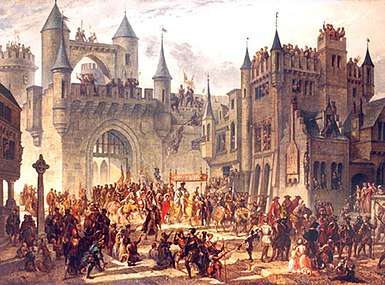
The Eighth Italian War of 1551–1559, sometimes known as the Habsburg–Valois War, began when Henry declared war against Holy Roman Emperor Charles V with the intent of recapturing Italy and ensuring French, rather than Habsburg, domination of European affairs. Persecution of Protestants at home did not prevent Henry II from becoming allied with German Protestant princes at the Treaty of Chambord in 1552. Simultaneously, the continuation of his father's Franco-Ottoman alliance allowed Henry II to push for French conquests towards the Rhine while a Franco-Ottoman fleet defended southern France.[11] An early offensive into Lorraine was successful. Henry captured the three episcopal cities of Metz, Toul, and Verdun, and secured them by defeating the Habsburg army at the Battle of Renty in 1554.[12] However the attempted French invasion of Tuscany in 1553 was defeated at the Battle of Marciano.

After the abdication of Charles V in 1556, the Habsburg empire was split between Philip II of Spain and Holy Roman Emperor Ferdinand I. The focus of Henry's conflict with the Habsburgs shifted to Flanders, where Phillip, in conjunction with Duke Emmanuel Philibert of Savoy, defeated the French at the Battle of St. Quentin (1557). England's entry into the war later that year led to the French capture of Calais, and French armies plundered Spanish possessions in the Low Countries. Henry was nonetheless forced to accept the Peace of Cateau-Cambrésis, in which he renounced any further claims to territories in Italy.[13]
The Peace of Cateau-Cambrésis was signed between Henry and Elizabeth I of England on 2 April[14] and between Henry and Philip II of Spain on 3 April 1559 at Le Cateau-Cambrésis. Under its terms, France restored Piedmont and Savoy to Duke Emmanuel Philibert, but retained Saluzzo, Calais, and the bishoprics of Metz, Toul, and Verdun. Spain retained Franche-Comté. Emmanuel Philibert married Henry's sister Margaret of France, Duchess of Berry, and Philip II of Spain married Henry's daughter Elizabeth of Valois.[15]
Henry raised the young Mary, Queen of Scots, at his court, hoping to use her ultimately to establish a dynastic claim to Scotland. On 24 April 1558, Henry's fourteen-year-old son, the Dauphin Francis, married Mary. Had there been a son of this union, he would have been King of France and King of Scotland, and also a claimant to the throne of England. Henry had Mary sign secret documents, illegal in Scottish law, that would ensure Valois rule in Scotland even if Mary died without leaving a child by Francis.[16] (As it happened, Francis died without issue a year and half after his father, ending the French claim to Scotland.)
Patent innovation

Henry II introduced the concept of publishing the description of an invention in the form of a patent. The idea was to require an inventor to disclose his invention in exchange for monopoly rights to the patent. The description is called a patent "specification". The first patent specification was submitted by the inventor Abel Foullon for "Usaige & Description de l'holmetre" (a type of rangefinder). Publication was delayed until after the patent expired in 1561.[17]
Death

Henry II was an avid hunter and a participant in jousts and tournaments. On 30 June 1559, a tournament was held near Place des Vosges to celebrate the Peace of Cateau-Cambrésis with his longtime enemies, the Habsburgs of Austria, and to celebrate the marriage of his daughter Elisabeth of Valois to King Philip II of Spain. During a jousting match, King Henry, wearing the colors of his mistress Diane de Poitiers,[18] was wounded in the eye by a fragment of the splintered lance of Gabriel Montgomery, captain of the King's Scottish Guard.[19] Despite the efforts of royal surgeon Ambroise Paré, the king died of sepsis on 10 July 1559.[20] He was buried in a cadaver tomb in Saint Denis Basilica. Henry's death played a significant role in the decline of jousting as a sport, particularly in France.[21]
As Henry lay dying, Queen Catherine limited access to his bedside and denied his mistress Diane de Poitiers permission to see him, even though he repeatedly asked for her. Following his death, Catherine sent Diane into exile, where she lived in comfort on her own properties until her death.[18]
It was the practice to enclose the heart of the king in an urn. The Monument to the Heart of Henry II is in the collection of the Louvre, but was originally in the Chapel of Orleans beneath a pyramid. The original bronze urn holding the king's heart was destroyed during the French Revolution and a replica was made in the 19th century. The marble sculpture of the Three Graces holding the urn, executed from a single piece of marble by Germain Pilon, the sculptor to Catherine de' Medici, survives.[22]
Henry was succeeded by his sickly fifteen-year-old son, Francis II.[23] Francis was married to sixteen-year-old Mary, Queen of Scots, who had been his childhood friend and fiancée since her arrival at the French court when she was five.[24] Francis II died in December 1560, and Mary returned to Scotland in August 1561.[25] Francis II was succeeded by his ten-year-old brother Charles IX. His mother, Catherine de Medici, acted as regent.[26]
Issue
Catherine de' Medici bore 10 of Henry's children:[27] (See Children of Henry II of France and Catherine de' Medici)
- Francis II, born 19 January 1544, who married Mary, Queen of Scots
- Elizabeth of France, born 2 April 1545, who married Philip II, King of Spain
- Claude, born 12 November 1547, who married Charles III, Duke of Lorraine
- Louis, Duke of Orléans, born 3 February 1549, died 24 October 1550
- Charles IX, born 27 June 1550
- Henry III, born 19 September 1551, also briefly King of Poland
- Margaret, born 14 May 1553, who married Henry III, King of Navarre
- Hercules, born 18 March 1555, later known as Francis, Duke of Alençon and Anjou.
- Victoria, born 24 June 1556, died 17 August 1556
- Joan, stillborn 24 June 1556
Henry II also had three illegitimate children:
- By Filippa Duci:[28]
- Diane, duchesse d'Angoulême (1538–1619). At the age of fourteen, the younger Diane married Orazio Farnese, Duke of Castro,[29] who died in battle in 1553. Her second marriage was to François, Duke of Montmorency.[30]
- By Lady Janet Stewart (1508–1563), the illegitimate daughter of James IV of Scotland:[31]
- Henri d'Angoulême (1551 – June 1586).[32] He was legitimized and became governor of Provence.
- Henri de Saint-Rémy (1557–1621).[33] He was given the title of Count of Saint-Rémy. One of his last descendants was Jeanne de Valois-Saint-Rémy, Countess de la Motte, famous for her role in the Affair of the Diamond Necklace at the court of Louis XVI.
Portrayals
Henri or Henry has had three notable portrayals on the screen.
He was played by a young Roger Moore in the 1956 film Diane, opposite Lana Turner in the title role and Marisa Pavan as Catherine de Medici.[34]
In the 1998 film Ever After, the Prince Charming figure who is portrayed by Dougray Scott, shares his name with the historical monarch.[35]
In the 2013 CW series Reign he is played by Alan van Sprang.[36]
Gallery
 Royal Monogram
Royal Monogram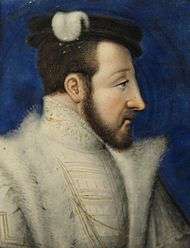 Detail from portrait plaque, enamel and gilding on copper
Detail from portrait plaque, enamel and gilding on copper Henry II, here standing on an oriental carpet, continued the policy of Franco-Ottoman alliance of his father Francis I. Painting by François Clouet.
Henry II, here standing on an oriental carpet, continued the policy of Franco-Ottoman alliance of his father Francis I. Painting by François Clouet.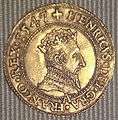 Coin of Henry II, 1547
Coin of Henry II, 1547 "Bastard culverin" of 1548, with arms of Henri II and Catherine de Medicis and crescent of Diane de Poitiers. Caliber: 85mm, length: 300 cm, weight: 1076 kg.
"Bastard culverin" of 1548, with arms of Henri II and Catherine de Medicis and crescent of Diane de Poitiers. Caliber: 85mm, length: 300 cm, weight: 1076 kg.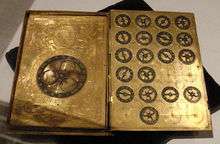 A cypher machine in the shape of a book, with arms of Henri II.
A cypher machine in the shape of a book, with arms of Henri II.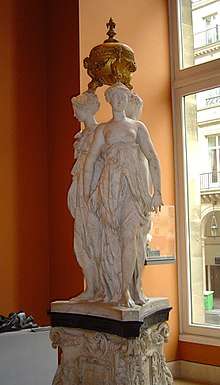 Monument to the Heart of Henry II, Louvre, Paris, sculpture of the Three Graces by Germain Pilon holding a replica of the urn that contained the king's heart
Monument to the Heart of Henry II, Louvre, Paris, sculpture of the Three Graces by Germain Pilon holding a replica of the urn that contained the king's heart
Ancestry
| Ancestors of Henry II of France | ||||||||||||||||||||||||||||||||||||||||||||||||||||||||||||||||||||||||||||||||||||||||||||||||||||||||||||||||||||||||||||||||||||||||||||||||||||||||||||||||||||||||||||||||||||||||||||||||||||||||||||||||||||||||||||||||||||||||||||||||||||||||||||||||||||||||||||||||||||||||||||||||||||||||||||||||||||||||||||||||||||||||||||||||||||||||||||||||||||||||||||||||||||||||||||||||||||||||||||||||||||||||||||||||||||||||||||||||||||||||||||||||||||||||||||||||||||||||||||||||||||||||||||||||||||||||||||||||||||||||||||||||||||||||||||||||||||||||||||||||||||||||||||||||||||||||||||||||
|---|---|---|---|---|---|---|---|---|---|---|---|---|---|---|---|---|---|---|---|---|---|---|---|---|---|---|---|---|---|---|---|---|---|---|---|---|---|---|---|---|---|---|---|---|---|---|---|---|---|---|---|---|---|---|---|---|---|---|---|---|---|---|---|---|---|---|---|---|---|---|---|---|---|---|---|---|---|---|---|---|---|---|---|---|---|---|---|---|---|---|---|---|---|---|---|---|---|---|---|---|---|---|---|---|---|---|---|---|---|---|---|---|---|---|---|---|---|---|---|---|---|---|---|---|---|---|---|---|---|---|---|---|---|---|---|---|---|---|---|---|---|---|---|---|---|---|---|---|---|---|---|---|---|---|---|---|---|---|---|---|---|---|---|---|---|---|---|---|---|---|---|---|---|---|---|---|---|---|---|---|---|---|---|---|---|---|---|---|---|---|---|---|---|---|---|---|---|---|---|---|---|---|---|---|---|---|---|---|---|---|---|---|---|---|---|---|---|---|---|---|---|---|---|---|---|---|---|---|---|---|---|---|---|---|---|---|---|---|---|---|---|---|---|---|---|---|---|---|---|---|---|---|---|---|---|---|---|---|---|---|---|---|---|---|---|---|---|---|---|---|---|---|---|---|---|---|---|---|---|---|---|---|---|---|---|---|---|---|---|---|---|---|---|---|---|---|---|---|---|---|---|---|---|---|---|---|---|---|---|---|---|---|---|---|---|---|---|---|---|---|---|---|---|---|---|---|---|---|---|---|---|---|---|---|---|---|---|---|---|---|---|---|---|---|---|---|---|---|---|---|---|---|---|---|---|---|---|---|---|---|---|---|---|---|---|---|---|---|---|---|---|---|---|---|---|---|---|---|---|---|---|---|---|---|---|---|---|---|---|---|---|---|---|---|---|---|---|---|---|---|---|---|---|---|---|---|---|---|---|---|---|---|---|---|---|---|---|---|---|---|---|---|---|---|---|---|---|---|---|---|---|---|---|---|---|---|---|---|---|---|---|---|---|---|---|---|---|---|---|---|---|---|---|---|---|---|---|---|---|---|---|---|---|---|---|---|---|---|---|---|---|---|---|---|---|---|---|---|---|---|---|---|---|---|---|---|---|---|---|---|---|---|---|---|---|---|---|---|---|---|---|---|---|---|---|---|---|---|---|---|---|---|---|---|---|---|---|---|---|---|---|---|---|---|---|---|---|---|---|---|---|---|---|---|---|---|---|---|---|---|---|---|---|---|---|---|---|---|---|---|---|---|---|---|---|---|---|---|---|---|---|---|---|---|---|---|---|---|---|---|---|---|---|---|---|---|---|---|---|---|---|---|---|---|---|---|---|---|---|---|---|---|
| ||||||||||||||||||||||||||||||||||||||||||||||||||||||||||||||||||||||||||||||||||||||||||||||||||||||||||||||||||||||||||||||||||||||||||||||||||||||||||||||||||||||||||||||||||||||||||||||||||||||||||||||||||||||||||||||||||||||||||||||||||||||||||||||||||||||||||||||||||||||||||||||||||||||||||||||||||||||||||||||||||||||||||||||||||||||||||||||||||||||||||||||||||||||||||||||||||||||||||||||||||||||||||||||||||||||||||||||||||||||||||||||||||||||||||||||||||||||||||||||||||||||||||||||||||||||||||||||||||||||||||||||||||||||||||||||||||||||||||||||||||||||||||||||||||||||||||||||||
Notes
- Baumgartner 1988, pp. 3–4.
- Tazón 2003, p. 16.
- Knecht 1984, p. 189.
- Watkins 2009, pp. 79–80.
- Wellman 2013, p. 197.
- Wellman 2013, p. 200.
- Thevet 2010, pp. 24–25.
- Baumgartner 1988, pp. 114–132.
- Loach 2014, p. 107.
- Felix & Juall 2016, p. 2.
- Inalcik 1995, p. 328.
- Thevet 2010, p. 92.
- Konnert 2006, p. 97.
- Nolan 2006, p. 127.
- Knecht 2000, p. 1.
- Guy 2012, p. 91.
- Frumkin 1945, p. 143.
- Wellman 2013, p. 213.
- Baumgartner 1988, p. 250.
- Baumgartner 1988, p. 252.
- Barber, Richard; Barker, Juliet (1 January 1989). Tournaments: Jousts, Chivalry and Pageants in the Middle Ages. Boydell. pp. 134, 139. ISBN 978-0-85115-470-1.
- Goldberg 1966, p. 206-218.
- Knecht 1997, p. 59.
- Baumgartner 1988, pp. 67–69.
- Fraser 1991, p. 900.
- Knecht 1997, p. 72.
- Anselme 1726, pp. 134–136.
- Merrill 1935, p. 133.
- Baumgartner 1988, p. 70.
- Lanza 2007, p. 29.
- Sealy 1981, p. 206.
- Wellman 2013, p. 212.
- Knecht 1997, p. 38.
- Diane at the TCM Movie Database
- Ever After at AllMovie
- Wilford, Denette (16 October 2013). "'Reign' Cast Gets Down And Dirty With Details on Royal TV Show". The Huffington Post. Retrieved 7 February 2014.
- Adams, Tracy (2010). The Life and Afterlife of Isabeau of Bavaria. Johns Hopkins University Press. p. 255.
- Knecht, R.J. (1984). Francis I. Cambridge University Press. pp. 1–2.
- Gicquel, Yvonig (1986). Alain IX de Rohan, 1382–1462: un grand seigneur de l'âge d'or de la Bretagne (in French). Éditions Jean Picollec. p. 480. ISBN 9782864770718.
- Palluel-Guillard, André. "La Maison de Savoie" (in French). Conseil Savoie Mont Blanc. Retrieved 28 June 2018.
- Jackson-Laufer, Guida Myrl (1999). Women Rulers Throughout the Ages: An Illustrated Guide. ABC-CLIO. p. 231.
- Leguai, André (2005). "Agnès de Bourgogne, duchesse de Bourbon (1405?–1476)". Les ducs de Bourbon, le Bourbonnais et le royaume de France à la fin du Moyen Age [The dukes of Bourbon, the Bourbonnais and the kingdom of France at the end of the Middle Ages] (in French). Yzeure: Société bourbonnaise des études locales. pp. 145–160.
- Wilson, Katharina M. (1991). An Encyclopedia of Continental Women Writers. Taylor & Francis. p. 258. ISBN 9780824085476.
- Anselme de Sainte-Marie, Père (1726). Histoire généalogique et chronologique de la maison royale de France [Genealogical and chronological history of the royal house of France] (in French). 1 (3rd ed.). Paris: La compagnie des libraires. pp. 134–136.
- Anselme 1726, p. 207
- Robin, Diana Maury; Larsen, Anne R.; Levin, Carole (2007). Encyclopedia of Women in the Renaissance: Italy, France, and England. ABC-CLIO. p. 20. ISBN 978-1851097722.
- Desbois, François Alexandre Aubert de la Chenaye (1773). Dictionnaire de la noblesse (in French). 6 (2nd ed.). p. 452. Retrieved 28 June 2018.
References
- Anselme de Sainte-Marie, Père (1726). Histoire généalogique et chronologique de la maison royale de France [Genealogical and chronological history of the royal house of France] (in French). 1 (3rd ed.). Paris: La compagnie des libraires. pp. 134–136.
- Baumgartner, Frederic J (1988). Henry II, King of France, 1547–1559. Duke University Press.CS1 maint: ref=harv (link)
- Inalcik, Halil (1995). "The Heyday and Decline of the Ottoman Empire". In Holt, P.M.; Lambton, Ann Katherine Swynford; Lewis, Bernard (eds.). The Cambridge History of Islam. Vol. 1A. Cambridge University Press.CS1 maint: ref=harv (link)
- Felix, Regina R.; Juall, Scott D., eds. (2016). Cultural Exchanges Between Brazil and France. Purdue University Press.CS1 maint: ref=harv (link)
- Frumkin, M. (1945). "The Origin of Patent". Journal of the Patent Office Society. XXVII (No. 3 March).CS1 maint: ref=harv (link)
- Fraser, Antonia (1991). "Mary, byname Mary Queen of Scots". The New Encyclopædia Britannica. 7. pp. 900–901.CS1 maint: ref=harv (link)
- Goldberg, Victoria L. (1966). "Graces, Muses, and Arts: The Urns of Henry II and Francis I". Journal of the Warburg and Courtauld Institutes. 29.CS1 maint: ref=harv (link)
- Guy, John (2012). My Heart is my Own: The Life of Mary Queen of Scots. Penguin Books Ltd.CS1 maint: ref=harv (link)
- Knecht, R.J. (1984). Francis I. Cambridge University Press.CS1 maint: ref=harv (link)
- Knecht, R. J. (1997). Catherine De'Medici. Longman.CS1 maint: ref=harv (link)
- Knecht, R.J. (2000). The French Civil Wars, 1562–1598. Pearson Education Ltd.CS1 maint: ref=harv (link)
- Konnert, Mark (2006). Early Modern Europe: The Age of Religious War, 1559–1715. University of Toronto Press.CS1 maint: ref=harv (link)
- Lanza, Janine M (2007). From Wives to Widows in Early Modern Paris: Gender, Economy, and Law. Ashgate Publishing.CS1 maint: ref=harv (link)
- Loach, Jennifer (2014). Edward VI. Yale University Press.CS1 maint: ref=harv (link)
- Merrill, Robert V. (1935). "Considerations on "Les Amours de I. du Bellay"". Modern Philology. 33 (No. 2 Nov).CS1 maint: ref=harv (link)
- Nolan, Cathal J., ed. (2006). "Cateau-Cambresis". The Age of Wars of Religion, 1000–1650: An Encyclopedia of Global Warfare and Civilization. Vol. 1. Greenwood Press.CS1 maint: ref=harv (link)
- Nostradamus, César (1614). Histoire et Chronique de Provence. Simon Rigaud.CS1 maint: ref=harv (link)
- Sealy, Robert J. (1981). The Palace Academy of Henry III. Droz.CS1 maint: ref=harv (link)
- Tazón, Juan E. (2003). The life and times of Thomas Stukeley (c.1525–78). Ashgate Publishing Ltd.CS1 maint: ref=harv (link)
- Thevet, André (2010). Portraits from the French Renaissance and the Wars of Religion. Translated by Benson, Edward. Truman State University Press.CS1 maint: ref=harv (link)
- Thorndike, Lynn (1941). History of Magic and Experimental Science. Volume 6. New York: Columbia University Press. Retrieved 23 October 2017.CS1 maint: ref=harv (link)
- Watkins, John (2009). "Marriage a la Mode, 1559:Elisabeth de Valois, Elizabeth I, and the Changing Practice of Dynastic Marriage". In Levin, Carole; Bucholz, R. O. (eds.). Queens and Power in Medieval and Early Modern England. University of Nebraska Press.CS1 maint: ref=harv (link)
- Wellman, Kathleen (2013). Queens and Mistresses of Renaissance France. Yale University Press.CS1 maint: ref=harv (link)
External links
| Wikimedia Commons has media related to Henry II of France. |
- Henry II of France History Today V.59 I9.
- Michael Servetus Research- Naturalization Scholarly graphical study on a document issued by Henry II of France in 1548 & 1549
Henry II of France Cadet branch of the Capetian dynasty Born: 31 March 1519 Died: 10 July 1559 | ||
| Regnal titles | ||
|---|---|---|
| Preceded by Francis I |
King of France 31 March 1547 – 10 July 1559 |
Succeeded by Francis II |
| French nobility | ||
| Vacant Title last held by Louis II |
Duke of Orléans 1519–1536 |
Succeeded by Charles II |
| Preceded by Francis III |
Duke of Brittany 10 August 1536 – 31 March 1547 |
Merged in crown |
| French royalty | ||
| Preceded by Francis |
Dauphin of France 10 August 1536 – 31 March 1547 |
Succeeded by Francis |